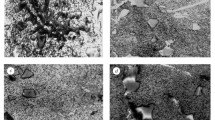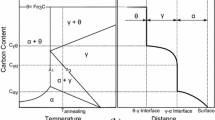The nature of eutectic carbide formation in economically alloyed high-speed steels with supplementary addition of niobium and titanium is considered. Changes in matrix and carbide chemical composition in relation to heat treatment stages are discussed. An experimental steel is recommended as a replacement for classical steel R6M5.
Similar content being viewed by others
Avoid common mistakes on your manuscript.
Introduction
In view of an increasing shortage of main alloying elements (W, Mo, Co, V) work for studying more economically alloyed high-speed steels than “basic” production steel R6M5 becomes important, used for treatment with normal cutting rates with carbon- and medium-alloy structural steels with strength of 900 – 1000 MPa (150 – 250 HB ), and also stainless steels [1].
For a long time steel R18 was the sole high-speed steel used for all tools and different cutting conditions. Since 1939 – 40 measures were started for creating high-speed steels with a lower tungsten content without marked detriment to their main properties. In particular, within the USA steel S6-5-1 (M2) was developed, which is currently the main high speed steel grade in all developed countries. Approximately in these years within the USSR low-alloy steels of the types R0M3F3, R3M3F2, and R3AM3F3 were developed, which are inferior as a rule to steel R6M5, only providing about 75 – 80% of its productivity [2].
Attempts to improve steel properties with respect to creation of more economic materials, attempts were made by supplementary alloying and modification with less scarce elements, mainly carbide-formers, nitrogen, REM, etc. However, data about the effect of these elements on properties of high-speed steels were unclear, and moreover often quite contradictory. There were also contradictory opinions about the effect of titanium and niobium. Currently titanium and niobium attract greater attention as a substitute for vanadium in high-speed steels [3, 4]. In spite of existence of a considerable number of patents, there are no national standards for titanium-and niobium-containing high-speed steels.
There has also been extensive development recently of technology for utilizing high-tungsten industrial waste for tool steel smelting [5, 6]. However, it is not always possible to obtain material properties at a high level as a result of a considerable number of deleterious impurities within scrap.
In this work attempts are made for comprehensive research of the effect of titanium and niobium on structure formation for economically alloyed high-speed steel with the aim of more profound understanding of carbide phase transformations affecting conditions for service property formation.
Methods of Study
Research was carried out on steel specimens type R3AM3F2, which was additionally alloyed with niobium (1.26 – 1.28 wt.%) and titanium (0.2 wt.%), for the first version, and 1.55 wt.% for the second version (Table 1). These elements were selected as a result of high affinity for carbon and the possibility of forming special carbides, capable of improving material operating properties.
Specimens for studying eutectic carbides in cast metal were cut from the axial zone of transverse templates, selected over the height from the central part of an ingot weighing 20 kg. First the ingots were annealed at 850°C, 2 h, and then quenched from 1210°C, and threefold tempering at 560°C for 1 h.
In order to exclude procedural errors the specimens studied were packed in a single holder, ground, polished, and then thermally etched in order to reveal carbides. This methodology makes it possible to evaluate reliably the content of elements within a microvolume by XRMAdue to an insignificant oxide film at the surface of objects, not contributing significant distortions in determining the intensity of characteristic radiation. At the same time, even an insignificant degree of alloying by different elements changes the light range (for both carbides and matrix), and this makes it possible to identify clearly different material structural components.
X-ray microanalysis was performed in a RÉM-106I scanning electron microscope under the following conditions: accelerating voltage 20 kV, probe current 20 mA.
A study of carbide composition was carried out for points recording the intensity of characteristic radiation for K α-lines for titanium, chromium, and iron, and L α-lines for niobium, molybdenum and tungsten, previously selecting carbides with respect to their image on a background of absorbed electrons. Pure elements were used as standards. Since the carbon content was not determined, then it was calculated as addition up to 100%. The final carbide composition was established by standardizing the concentration of measured elements for a proposed carbide type.
Since there are heavy elements within carbides, then the error in their determination did not exceed ± 0.1 wt.%.
Results and Discussion
As is well known [7], in cast steel type R3AM3F2 carbides of the types M6C, MC, and M2C crystallize, which may form eutectic colonies. This structure is determined by the concentration of vanadium, and overall tungsten and molybdenum content, i.e., the amount of carbide-forming elements and their ratio. As a rule after heat treatment M2C carbide breaks down into M6C and MC.
Additional alloying with niobium (steel 1 ) does not lead to a change in carbide type in a cast condition (Table 2). However, within the steel structure there are no M6C type carbides, which are replaced anew by developing carbides based on titanium and niobium. VC type carbide also became additionally alloyed with titanium and niobium.
With introduction of an increased amount of titanium (steel 2 ) there is an increase in the amount of it within MC carbides, and there is also alloying of carbides, within which its absence was observed. Additional alloying with titanium leads to generation of M6C type carbide and disappearance of M2C and MC (NbC) carbides. Combined steel alloying with titanium and niobium facilitates formation of M6C eutectic carbides, and also leads to development of complexly alloyed titanium-niobium carbide MC [(TiNb)C]. Thus, an increase in steel alloying facilitates and increase in amount of additional elements within carbides, and this also means the possibility of an improvement in steel properties.
After a complete heat treatment cycle the nature of a carbide phase changes. In steel 1 M2C carbide breaks down and forms M6C type carbide, although primary carbides of the MC type are almost unchanged. This phase composition behavior is regular and predicted.
Carbide morphology is typical, and TiC carbide (Fig. 1 a ) has the form of “Chinese hieroglyphs” with a developed surface.
Carbide NbC (Fig. 1 b ) has atypical hexagonal shape, which is located uniformly over the area of a microsection. Feather branching from hexagons is also observed, and this is classified as M2C carbide; this structure is explained by crystallization conditions from a liquid-solid state.
There is breakdown of M2C carbide in steel R3AM3F2B1T1 (steel 2 ) after heat treatment, although M6C type carbide is also present in a cast condition.
Alongside TiC carbide of the same morphology, as within steel 1, there is formation of a “complex” carbide type (TiNb)C (Fig. 1 c ). Its shape differs significantly from that of TiC carbide: it acquires an outline of trihedrons, pentagons, and sometimes hexagons. The amount of niobium within this carbide is at a maximum, and there is a relatively considerable amount of titanium, which may lead to a marked improvement of steel operating properties.
NbC carbide is absent from steel 2, and after heat treatment a “complex” carbide type (VNb)C forms. Its structure in untypical for this steel, and it is included in formation of a “complexly-alloyed” carbide on an NbC substrate (Fig. 1 d ).
As is seen from Fig. 1 d, a branched (VNb)C carbide emerges from a (TiNb)C carbide polyhedron, which may be explained by the similarity of the crystal lattices of these carbides.
Comparative tests for the life of tools prepared from experimental steels, and classical high-speed steel R6M5, were carried out on structural material with different cutting regimes (Table 3). For each tool workpiece cutting rate (v ), cutting depth (S ), feed rate (t ), and rotation frequency (n ) were measured.
Analysis of test results showed insignificant scatter for the indices obtained. During operation of a tool made from steel R3AM3F2B1T (steel 1 ) its life was shorter than that of a tool made from classical steel only in three cases, and with cutting for a tool made from steel R3AM3F2B1T1 (steel 2 ) only in two cases (although the relative life in these cases is not lower than 94%).
Thus, economically alloyed steel R3AM3F2B1T1, whose properties in some cases even surpass the relative life values, may be recommended as a substitute for steel R6M5.
Conclusions
-
1.
Heat treatment leads to a change in concentration of carbide-forming elements in steel solid solution. This is caused by dispersion hardening, spheroidization, and coagulation in different heating stages.
-
2.
Introduction of niobium does not lead to a change i excess phase type in steel 1, although existing carbides are additionally alloyed with Ti and Nb.
-
3.
The combined effect of titanium and niobium (steel 2 ) on qualitative composition of carbides and a change in their alloying has been revealed, which approaches this steel with respect to eutectic component for classical steel R6M5.
-
4.
Analysis of full-scale tests showed satisfactory results for the life of a cutting tool of the test steels. A longer life applies to experimental steel R3AM3F2B1T1, which is recommended for use as a replacement for classical steel R6M5.
References
E. Gudremont, Special Steels [in Russian], Metallurgiya, Moscow (1966).
Yu. A. Geller, Tool Steels [in Russian], Metallurgiya, Moscow (1975).
A. S. Chaus, “Modification of cast tungsten-molybdenum highspeed steels with niobium, zirconium, and titanium,” Metalloved. Term. Obrab. Met., No. 6, 16 – 21 (2005).
A. Yulmas, “Microstructural analysis of new cast high-speed steel alloyed with niobium,” Metalloved. Term. Obrab. Met., No. 7, 28 – 32 (2012).
A. A. Glotka, Development and Analysis of Structure-Phase State of Ni – W and Fe – W Alloys Based on Refractory W – Ni – Fe Scrap for Alloying Special Materials in Gas Turbine Building, Author’s Abstract of Candidate’s Thesis, Zaporozhe (2011).
G. A. Kolobov and V. S. Panov, “New technology for processing tungsten and hard alloy waste,” in: Metallurgy. Scientific Work of the Zaporozh’e State Engineering Academy, ZGIA, Zaporozhe (2013), No. 1, pp. 64 – 72.
L. D. Moshkevich, S. I. Tishaev, N. E. Evlampieva, and A. N. Kurasov, “Features of eutectic carbide formation in high-speed steels,” Stal’, No. 10, 62 – 67 (1982).
Author information
Authors and Affiliations
Corresponding author
Additional information
Translated from Metallovedenie i Termicheskaya Obrabotka Metallov, No. 5, pp. 20 – 24, May, 2015.
Rights and permissions
About this article
Cite this article
Moroz, A.N., Glotka, A.A. Nature of Eutectic Carbide Formation in Economically Alloyed High-Speed Steels. Met Sci Heat Treat 57, 264–267 (2015). https://doi.org/10.1007/s11041-015-9872-8
Published:
Issue Date:
DOI: https://doi.org/10.1007/s11041-015-9872-8





